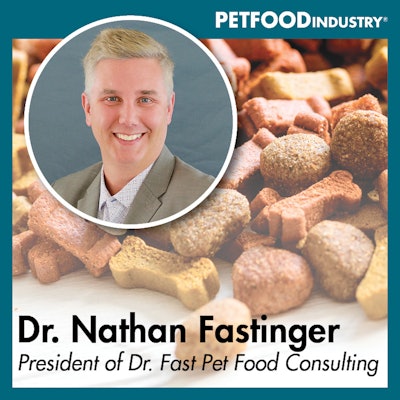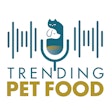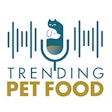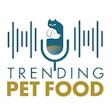
What do consumers think of animal plasma proteins? What is the role of a functional protein in a pet food recipe? There’s a lot happening in both the functional ingredient and protein spaces right now in pet food. Together, Lindsay Beaton, host of Trending: Pet Food, and Dr. Nathan Fastinger, president of Dr. Fast Pet Food Consulting, dive deep into the topic during this episode that answers the question, "What role do functional protein ingredients currently play in pet food formulation?"
The below transcript is from Episode 36 of the Trending: Pet Food podcast, where host Lindsay Beaton spoke with Dr. Nathan Fastinger, president of Dr. Fast Pet Food Consulting. The two explore functional protein ingredients, what consumers think of them, and what might be coming down the road. You can find the episode at Trending: Pet Food Podcast, on SoundCloud or on your favorite podcast platform. This episode originally aired in June 2023.
Lindsay Beaton – Editor, Petfood Industry magazine and Host, Trending: Pet Food podcast: Hello, and welcome to Trending: Pet Food, the industry podcast where we cover all the latest hot topics and trends in pet food. I’m your host and editor of Petfood Industry magazine Lindsay Beaton, and I’m here today with Dr. Nathaniel Fastinger, president of Dr. Fast Pet Food Consulting. Hi Nathan, and welcome!
Dr. Nathan Fastinger, president of Dr. Fast Pet Food Consulting: Thanks, Lindsay. Happy to be here.
Beaton: In case you’re not familiar with Nathan or his consulting firm, here’s what you need to know. He earned his B.S., M.S., and Ph.D. in non-ruminant animal nutrition at The Ohio State University. He then completed a post-doctoral research position focusing on dog and cat nutrition at the University of Illinois - Urbana Champaign. While at Illinois he mentored 2 Ph.D. and 6 M.S. students while managing one of the largest graduate programs in Companion Animal Nutrition in the country.
Nathan joined Procter and Gamble Pet Care in 2006 as a nutritionist and formulator in R&D. His time at P&G included product development work with dry, wet and treat formulas in North America, Europe and Asia, including development of veterinary prescription diets. He then joined US Pet Nutrition/Thai Union/iTail as their pet food nutritionist, responsible for product development, nutritional compliance, training all product development scientists, new product development, and ensuring the finished products meet the consumers’ desired experience.
He also worked for PetSmart in their proprietary brands team developing new products, and at Perfection Pet Foods as the vice president of R&D supporting major national customers. In 2019, Nathan joined Thai Union again as the vice president of Technical Sales and Nutrition, supporting more than 50 brands of pet foods sold worldwide. Finally, in 2021, Nathan began operating his own consulting company in Tampa, Florida, with his wife Lynne.
Dr. Fast Pet Food Consulting focuses on dog and cat food and treats with help in formulation, nutritional analyses and formula reviews, nutritional compliance, AAFCO labelling, feeding studies, functional ingredients, and claims support. The consulting firm has extensive experience in formulating every type of pet food including dry kibble, starch-free kibble, freeze-dried, soft-moist, air-dried, human grade fresh and all types of wet foods.
Nathan’s expertise in formulation and pet nutrition is why I’ve brought him on today to answer this question: What role do functional protein ingredients currently play in pet food formulation?
I want to start with a 101-type question so we can hone in what our discussion is going to be. What exactly is a functional protein?
Fastinger: A functional protein provides a benefit besides just protein and amino acid content. Those functions can be water binding capacity, meat binding capacity, immune benefits, other health benefits, other processing benefits, besides simply providing protein and amino acids.
Beaton: What are some of the top functional proteins you're seeing in pet food formulation right now?
Fastinger: I would say the number one and number two are animal plasma and egg products, whether it's egg white or whole egg.
Beaton: There are some obvious differences between those two. But in terms of formulation, what might cause somebody to go for one over the other? What are the pros and cons of those two, and why are they so popular?
Fastinger: Both provide good binding at relatively similar levels for plasma versus egg white versus whole egg. There are some added benefits for plasma from an immune and digestibility standpoint that come into play when you're thinking about animal health, besides just a binder to help hold protein components together.
One of the other popular functional proteins is wheat gluten. But of course, that has kind of reduced in its popularity and consumer acceptance ever since the 2007 pet food recall that happened when they found the adulterated wheat gluten from China.
Beaton: Let's talk about the evolution of these ingredients a little bit because the landscape of pet food formulation in terms of both protein needs and functional ingredient needs has really changed in the last several years. I'm interested to hear how the landscape has changed for something that is both a protein and a functional ingredient put together.
Are you seeing some ingredients fall out of favor and some move up in interest? Are you seeing them perform more functions than they used to? How has that evolved in formulation in general, and then where do functional proteins come into play?
Fastinger: When you're looking at a functional protein, you have to decide based off a couple of different characteristics, one being What's the function that that protein provides? Is it simply a good meat binder, because typically, these products are used in wet pet foods where they're trying to make a reform of steamed tunneled chunks, where water binding capability and meat binding capability is the primary concern. That's how functional proteins were really born more of a processing a benefit than any immune or animal health benefits.
In the last 20 years, there's been a lot of data generated on some of those ingredients, including plasma, where there's numerous animal health benefits, whether it be immune benefits or digestive health benefits, that gives plasma the ability to do two functional parts -- it can help to bind meat and it can also provide some animal health benefits. Whereas wheat gluten is simply added to bind to meat, egg protein is typically added just to bind meat. So there's the development of added benefits, and more and more data being generated to show the benefit of the other part of functional protein, which is the animal health benefit.
Beaton: Did that research begin after customers and pet owners started asking for more from their functional ingredients? Because I feel like pet owners these days are looking for their pet food to do so much in terms of nutrition, in terms of preventive maintenance, that it seems like something like this would be a prime candidate. It's already been used as a binding agent, it's a protein, it probably has some nutritional benefits. Was that kind of a kickstart? Or was the research already happening and it just increased as people need more out of their formulations?
Fastinger: I think it was a push-pull situation. Push from the industry in that plasma has been used for 30 years in the animal health, especially for like growing piglets, baby chicks, calf milk replacers, all those production animals who are more prone to have some digestive health or immune health benefit. The more people realize that they are looking for an immune or digestive health benefit in their pet food, that's what the pull is from.
Consumers are desiring, like you said, their products to do more than just provide nutrition. And as you look across the landscape of ingredients that are available, there are very few that can provide nutrition and provide other intestinal and digestive and immune health benefits. I think the consumer, if you ask them today, what plasma does, most of them would not know. If you share the data, there's over 600 published research articles in animals on plasma, showing benefits across immune function, digestive health, recovery from diseases and disease challenges, it becomes really easy to explain the benefit to those consumers.
There's also an added benefit of palatability. Typically egg products are neutral, they don't provide a benefit, but they also don't hurt the recipe in terms of palatability. There's a good data set out there in both dogs and cats showing that when you add plasma, you do get a benefit and bump up in the palatability of the product. So I think it's basically three or four added benefits of plasma.
Beaton: Are you finding that there's any kind of push back just because of the name? I know a lot of times there is this nutrition-marketing-consumer perception trifecta that goes on with a pet food ingredient that requires some education, kind of like what you've been talking about in terms of showing research to consumers. What exactly does it look like when it's on an ingredient label? And has there been any discussion with your clients about how to promote that or how to educate consumers in terms of using that as an ingredient?
Fastinger: Beef or pork plasma would get labeled as beef or pork plasma. It's fairly straightforward in terms of how the labeling is on the ingredient statement.
I do think the consumer, anytime there's blood products in a recipe, they automatically think there's some kind of “gross factor” simply because in the human food world in the U.S., we don't consume blood products like other countries and other regions of the world. There's blood sausages and blood soups all over outside of the U.S. It's just not something that is on a typical Americans plate, so that's the first thing: the “gross factor.”
Once you do the education, which I think for a plasma-included product is required, they are aware of “here's exactly what it is, here's how it works, here's the benefits, here's why we're using it.” Then it becomes very easy for them to understand “why.”
I have had clients before where I've suggested plasma in recipes, and they go out and do consumer research of, “hey, what happens if we put plasma in a recipe?” And they're like, “No way.” Then I said, “Go back and do the same study, but explain to him what plasma is and why we're adding it.” And they were all like, “Okay, let's do it.” It was an easy discussion. But it took that step of educating the consumer to get there.
Beaton: Anybody who listens to this podcast knows that I love a good education conversation, so I want to talk about it a little bit more. What is the best way to educate the consumer? Do you really play up the ingredient in your marketing? Is it something that you have on your website that's accessible research? How do you promote it to customers without triggering that “ick factor” from the start so that they can get the research first and then be okay with the ingredient by default?
Fastinger: I think you must do all of the above. You have to market it on your packaging, you have to market it on your website, and you have to provide some technical white paper that can help take it from a technical discussion down to more layman's terms of why the benefit?
Beaton: I think that makes a lot of sense, especially the taking things down into layman's terms. Is that something that you in your position as a consultant can help companies with? Or is that something that you're finding companies can do internally with their own nutritionists or their own veterinarians on staff?
Fastinger: I can do it either way. I can provide that information so that they can use it straightaway. I’m more than happy to also review what is being produced internally to make sure they're maximizing the messaging. I don't think that every nutritionist or veterinarian is fully aware of plasmas benefits either.
Beaton: I want to shift gears a little bit to the other protein that you talked about, egg protein. I know it's being used as an alternative protein in vegetarian formulas. Are you seeing a lot of that or call for that? And how has the use of egg protein evolved as we get more into this alternative protein conversation, vegetarian formulas, things like that?
Fastinger: Egg is a great protein source. It has a very good balance of amino acids, and it does a great job as a binder. It’s highly digestible. There is no bad aspect of egg other than the supply challenges over the past two years. With the highly pathogenic avian influenza (HPAI ) ravaging chicken and turkey and other poultry species around the world, the price of egg products has just skyrocketed. When you go to the grocery store, and you’re used to paying $1.30 or $1.40 for a dozen eggs, and now they're $5.80. You're feeling it in your own pocket as much as these pet food manufacturers are.
I think that that alone has reduced the demand for egg products in pet food, especially when you can go buy plasma, compared to egg whites, at maybe 25% of the cost.
Beaton: Wow, that is significant. Is there a reasonable alternative to egg protein that would still satisfy the vegetarian formulations? Or is that just something that people coming up with those formulas are struggling with right now?
Fastinger: In vegetarian diets, the focus for me would be on pea proteins, potato proteins, soy proteins with egg added at just enough to help balance amino acids. All the pea- and potato-based proteins are going to be lower cost than what egg is. If you were focused on egg as your primary protein source in these vegetarian diets, you're going to be having a rough time with profitability over the past couple of years and for the foreseeable future until HPAI gets behind.
Beaton: Since we've already kind of gone into it. What are some of the other challenges that you're seeing right now in terms of functional protein ingredients and pet food?
Fastinger: There are supply issues with wheat gluten, still due to the situation in Ukraine because they are a major exporter of wheat and also knowing that no one wants to buy wheat gluten out of China. But it's typically your lower end foods that are going to be binding with wheat-based products anyway.
Beaton: Are there any formulation challenges in terms of the amount of protein used like people doing double-duty wanting it to be a binding agent, but also wanting it to be a solid protein source? Is that something that plasma is used for? Or is it mostly a binding agent, and then there are some nutritional properties, but it's not used as a primary protein source. Does that make sense?
Fastinger: I think the biggest struggle is going to be trying to include it at a high level, because of the cost. You can buy chicken, dried chicken and dried chicken meals and animal meals that are a lot lower cost than what you can plasma.
Using it as the primary protein source is probably going to be a stretch to the ingredient cost. But the good part about plasma is you don't need to add very much to get the immune benefit and digestive health benefits. They can be as low as 2% to 5% of the recipe if you're going after some of the claims. Typically, people are not going to use plasma or egg as the primary protein source just due to recipe cost.
Beaton: Where are some of the top opportunities right now, in terms of functional proteins and using them in formulations?
Fastinger: I would say that the biggest area to focus are on the added benefits to the animal. There have been some brands recently who have launched lineups that have included plasma ingredients because they're firm believers in the animal's immune health benefit and digestive health benefit that comes along with it.
I've seen data recently on consumers searching for functional products, and both digestive health and immune health are coming at the top of the list. We're almost at a spot where it's a good situation for the push-pull approach, you have consumers searching for immune and digestive health benefits. You have data being generated in dogs and cats by some of the plasma suppliers, like a PC, that can help provide claims support to show in the species that you're targeting the benefit.
In the future, you'll see a lot more products, whether it's even supplements or complete and balanced foods that are going to start to include plasma into those recipes, because of the bonus of you get protein. It's a high-protein ingredient, high-quality protein because its animal based. There's still a trend toward animal-based protein for the higher end pet foods, then add in the benefit of immune and digestive health. You’ll continue to see data come out on plasma in dogs, and possibly cats, over the next couple of years as they start to hone in on other benefits, whether it's skin and coat or mobility benefits and joint-and-hip health.
Beaton: Is plasma particularly suited to a particular type of pet food or does it work across dry, wet, freeze-dried, whatever floats your boat?
Fastinger: What you're thinking of the functional part of is it a meat binder, that typically focuses into the wet pet food market segment. That’s where we're trying to take mechanically debunked meats and form them into a chunk that looks more beautiful and appealing to the consumer.
You can use it in every type of pet food if you're going after the functional immune and digestive health benefit. There's even a limited amount of data being generated that shows plasma allows you to, in a dry kibble, add more fresh meat to the recipe, which is an interesting approach.
Typically, fresh meat helps with palatability in a dry kibble, so the more you can put in, the higher the palatability compared to a chicken meal. We'll have to see where the data and processing studies take us, but I think there's some promising data being generated to be able to increase the amount of fresh meat content.
Beaton: Do you think there are any other functional proteins that are worth watching in the future as demand for functional proteins grow in formulations and people need different things to suit their nutritional requirements and formulations? Is there anything on the horizon that's worth looking at? Or is it the tried-and-true ones that are going to continue to evolve and be used in different ways?
Fastinger: I think it's going to be the tried-and-true ones that continue to grow. There's not much in terms of new ingredients out there that I've seen for functional protein products. I think it would be interesting if somebody is researching in that area to try to talk with them to see where their approach is taking them.
A lot of the ingredient’s suppliers, when they are developing something new, are going to be working with universities to get their foot in the door in terms of what types of data is needed and required. Most of these companies don't have their own research facilities, so they typically partner with some university to get it done.
Beaton: Thanks so much for speaking with me today, Nathan. There’s a lot happening in both the functional ingredient and protein spaces right now in pet food and seeing how they can team up to provide solutions is an important part of formulating conversation right now. Before we go, let’s do a little plug: where can people find more information about you and Dr. Fast Pet Food Consulting?
Fastinger: You can reach out to me by email at [email protected]. Or you can look me up on my LinkedIn page under Dr. Nathan Festinger. More than happy to help any company with any of their technical nutrition R&D.
Beaton: Excellent. That’s it for this episode of Trending: Pet Food. You can find us on petfoodindustry.com, SoundCloud, or your favorite podcast platform. You can also follow us on Instagram at @trendingpetfoodpodcast. And, if you want to chat or have any feedback, I’d love to hear from you! Feel free to drop me an email: [email protected].
Once again, I’m Lindsay Beaton, your host and editor of Petfood Industry magazine, and we’ll talk to you next time. Thanks for tuning in!

















